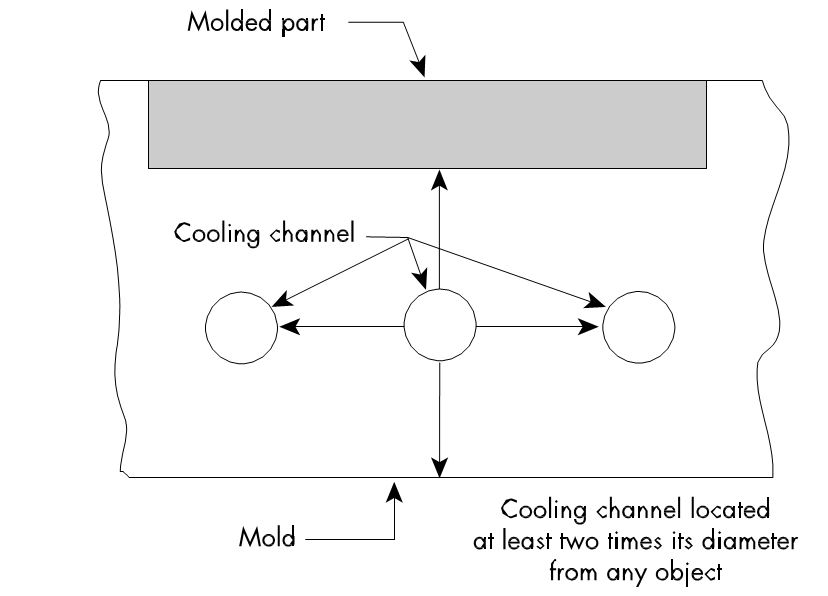What is injection mold cooling
Injection mold Cooling is a critical aspect of the injection molding process, as it directly influences the quality and efficiency of the produced plastic parts. Proper cooling helps in achieving uniform and consistent part quality, reducing cycle times, and improving overall production efficiency. Here are key considerations and methods for injection mold cooling:
Considerations for Injection Mold Cooling:
- Uniform Cooling:
- Achieving uniform cooling throughout the mold is crucial to prevent warpage and ensure consistent part quality.
- Uneven cooling can lead to variations in part dimensions and surface finish.
- Cycle Time Optimization:
- Efficient cooling can help reduce cycle times, improving overall production output.
- Rapid and uniform cooling is essential for quick and effective part ejection.
- Material Selection:
- The choice of mold material can impact the heat transfer and cooling process. High thermal conductivity materials, such as beryllium copper, can enhance cooling efficiency.
- Coolant Type:
- Common coolants include water and oil. Water is widely used due to its excellent heat transfer properties, but its use is limited by the temperature range it can handle. Oil-based cooling systems may be used for higher temperature applications.
- Cooling Channel Design:
- The design of cooling channels within the mold is critical. Channels should be strategically placed to ensure even cooling across the entire mold surface.
- Conformal cooling, where channels follow the contour of the mold, can enhance heat transfer and improve uniform cooling.
- Baffle Design:
- Baffles or inserts within the mold can direct the flow of coolant to specific areas, optimizing cooling efficiency.
- Temperature Control:
- Implementing temperature control units allows precise regulation of coolant temperature, ensuring consistent mold temperatures during production.
Methods for Injection Mold Cooling:
- Conventional Cooling:
- Using drilled cooling channels within the mold to circulate coolant (usually water) to absorb heat from the mold.
- Baffle Cooling:
- Introducing baffles or inserts in the mold to control the flow of coolant and direct it to specific areas that need more cooling.
- Heat Pipes:
- Utilizing heat pipes to transfer heat away from critical areas, improving cooling efficiency.
- Conformal Cooling:
- Designing cooling channels that follow the contours of the mold surface for more effective heat transfer.
- Mist Cooling:
- Using a mist of coolant sprayed directly onto the mold surface to enhance cooling.
- Cold Slug Well:
- Implementing a cold slug well to trap and solidify the initial molten plastic in the runner system, preventing it from reaching the mold cavity and causing localized overheating.
- Thermal Pins:
- Embedding thermal pins in the mold to enhance heat transfer and control temperature in specific areas.
Effective cooling strategies depend on the specific requirements of the injection molding process and the properties of the plastic material being used. It’s essential to consider these factors during the mold design process to achieve optimal cooling performance and ensure high-quality plastic parts.
Injection Mold cooling accounts for more than two-thirds of the total cycle time
Importance of injection mold cooling system design
Mold cooling accounts for more than two-thirds of the total cycle time in the production of injection molded thermoplastic parts. Figure 1 illustrates this point. An efficient cooling circuit design reduces the cooling time, which, in turn, increases overall productivity. Moreover, uniform cooling improves part quality by reducing residual stresses and maintaining dimensional accuracy and stability (see Figure 1).

Figure 1
Proper and efficient cooling improves part quality and productivity
Mold cooling system components
An Injection mold cooling system typically consists of the following items:
– Temperature controlling unit
– Pump
– Supply manifold
– Hoses
– Cooling channels in the mold
– Collection manifold
The mold itself can be considered as a heat exchanger, with heat from the hot polymer melt taken away by the circulating coolant.
A typical cooling system for an injection molding machine.
A cooling channel assembly attached to the mold plates.
We would like to take this opportunity to introduce our China mold maker company, Sincere Tech where you can find a wide range of high-quality plastic injection molds and related services.
We are committed to providing our customers with the best possible injection molding products and services. Our team of experienced professionals is dedicated to delivering top-notch solutions that meet your specific needs and requirements.
Our company features a user-friendly interface and is easy to navigate, making it simple for you to find the products and services you need. We offer a variety of services, including plastic mold, custom plastic injection molding, rapid prototyping, and mold design, post manufacturing, assembly and delivery.
Whether you are looking for a single prototype or a large-scale production run, we have the expertise and resources to meet your needs. Our team is always available to answer any questions you may have and to provide guidance and support throughout the process.
If you are looking for mould suppliers, contact us now. We are confident that you will find the solutions you need to take your business to the next level.
Thank you for considering sincere tech as your partner in plastic injection molding. We look forward to working with you.

